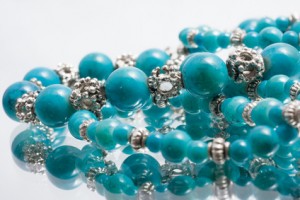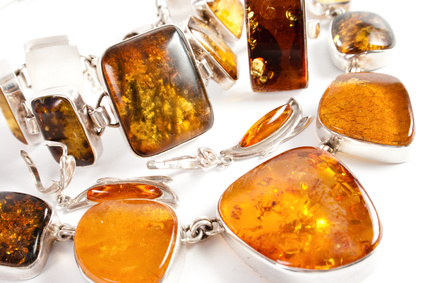What to Look For in Turquoise
Since turquoise is a water-based stone that forms in rocks, you will always notice pieces of the original rock within the stone.

Turquoise beads
Compared to diamonds, turquoise is porous because it has some amount of water content.
Generally, turquoise needs some kind of treatment to enhance its color and make it suitable for jewelry.
Always ask whether and how the stone has been treated before buying.
Natural turquoise is more expensive that treated varieties, and you should make sure you are not paying more than you need to.
Some vendors sell fake turquoise and it is not always easy to recognize it, especially if you are shopping online.
Generally, a natural stone will have a color that varies in intensity and is not perfectly even, whereas fakes look too perfect.
Keep in mind that sellers are legally required to disclose all treatment of the turquoise they sell and also whether the stone is real.
Types of Turquoise
Turquoise can be seen in different variations, including:
Natural Turquoise
No alteration is done to the stones. They are cut, shaped, and polished before placed into jewelry.
Natural turquoise tends to change color when it is exposed to oils, light, detergent, and perspiration. This is also the most expensive type.
Stabilized Turquoise
The natural mineral has been modified to harden the stone by using epoxy or acrylic to fill the material’s pores. This process preserves the stone’s color and ensures that it will not change over time.
While this type of turquoise makes great looking jewelry, it should be priced lower than natural turquoise.
Color-Enhanced Turquoise
Has undergone the same process as stabilized turquoise, but dye has been included to enhance the color of the stone.
This process uses soft, chalky, pale blue material and can be readily recognized because the color of the turquoise looks unnatural.
With a blade, this type of turquoise can be scratched easily, unlike a high quality turquoise.
Compared to natural or stabilized stone, color-enhanced turquoise is lower in price.
Reconstituted Turquoise
This type is made from chalky turquoise that is ground into powder and mixed with dyes and epoxy then molded into a solid form. The stone is then cut and placed into the jewelry.
These gemstones resemble natural turquoise but are priced much lower than treated turquoise.
Simulated Turquoise
This variety is made from plastic and contains no gemstone but is meant to imitate a turquoise.
These stones are categorized as costume jewelry and should be priced accordingly.
Things to Remember After the Purchase
• Do not wear turquoise jewelry while doing heavy work.
• Keep out of extreme weather.
• Do not use jewelry cleaners because the chemicals may harm the stone. Instead, use a soft cloth and clean with warm water.
• Store turquoise jewelry separately from other stones to prevent scratching.














